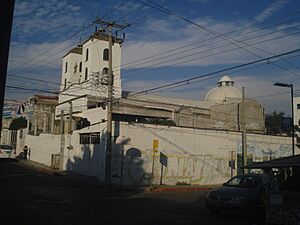San Pascualito facts for kids
Quick facts for kids San Pascualito |
|
|---|---|
| King of the Graveyard | |
| Venerated in | Folk Catholicism |
| Major shrine | Olintepeque, Guatemala |
| Feast | May 17 |
| Attributes | Skeletal figure, cape, crown, wheeled cart |
| Patronage | Curing diseases, death, healings, cures, vengeance, love, graveyards |
San Pascualito (also known as San Pascualito Muerte or El Rey San Pascual) is a special figure in folk religion. He is connected to Saint Paschal Baylon. People honor him in Guatemala and the Mexican state of Chiapas. He is often called the "King of the Graveyard."
Many believe San Pascualito can help cure illnesses. His worship is part of a larger tradition in Latin America that respects death, like the cult of death. Some think this tradition might come from ancient beliefs about a pre-Columbian death god. San Pascualito is usually shown as a skeleton. He sometimes wears a cape or a crown. The Roman Catholic Church does not officially approve of honoring San Pascualito.
Contents
Who is San Pascualito?
San Pascualito got his name from a Spanish friar named Paschal Baylon. A historian named Francisco Antonio de Fuentes y Guzmán wrote about him. He said that in 1650, Paschal Baylon appeared in a vision. This vision was seen by an indigenous man in San Antonio Aguacaliente. Today, this place is called Ciudad Vieja.
The man was very sick with a fever. It was called cucumatz in the Kaqchikel language. He had received his last rites, which are prayers for the dying. Then, a tall skeleton appeared to him in glowing robes.
A Promise and a Prophecy
The skeleton said he was "Saint Paschal Baylon." But Paschal Baylon was not officially made a saint until 1690. He had been declared "blessed" (a step before sainthood) in 1618. The figure promised to help stop the cucumatz sickness. He said this would happen if the community chose him as their patron saint. They would also need to honor his image.
To prove he was real, the figure made a prediction. He said the sick man would die within nine days. He also said the epidemic would end at the same time. The man did die within nine days, and the sickness stopped. News of this vision spread quickly. Soon, images of San Pascualito became very popular. This happened even though the Spanish Inquisition tried to stop it.
Honoring San Pascualito

There is a special chapel in Olintepeque, Guatemala, for El Rey San Pascual. People who believe in him leave thank you notes there. They also offer capes or light candles. The color of the candle shows what they are asking for.
- Red candles are for love.
- Pink candles are for health.
- Yellow candles are for protection.
- Green candles are for business.
- Blue candles are for work.
- Light blue candles are for money.
- Purple candles are for help against bad habits.
- White candles are for protecting children.
- Black candles are for revenge.
A festival is held every year on May 17. This is the same day as the feast day for Saint Paschal Baylon. Another important image of San Pascualito is in Tuxtla Gutiérrez. This is in the Mexican state of Chiapas. It is a seated skeleton on a wheeled cart. It is kept in the Church of San Pascualito there.
San Pascualito in Books
San Pascualito is a character in a book. He is called Pascal in the novel El tiempo principia en Xibalbá. This means "Time Commences in Xibalbá." The book was written by a Guatemalan author. His name is Luis de Lión (José Luis de León Díaz).
See also
 In Spanish: San Pascualito para niños
In Spanish: San Pascualito para niños

